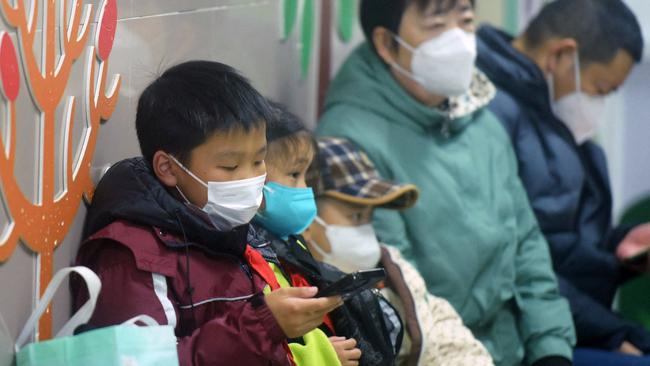What is HMPV and could we be facing a second pandemic? Experts weigh in
Experts are setting the record straight on Human metapneumovirus as outbreaks in northern China spark concern.

Reports of rising cases of Human metapneumovirus (HMPV) through China have sparked alarm.
The circumstances of the outbreak’s first announcement and a relative lack of knowledge of the condition fed into concerns that history was on the brink of repetition, despite advice to the contrary.
Infectious disease specialists are urging the public not to fear a second pandemic.
What is HMPV?

HMPV is a common respiratory disease that closely resembles a cold with similar symptoms and treatments. It was discovered a little under 25 years ago and health authorities have kept an eye on it since.
China’s surge in HMPV has coincided with winter, when colds and airborne diseases are prone to spread. It has mainly affected children and young teenagers, but that is not uncommon for varieties of the common cold, a bracket that HMPV falls under.
“It has been monitored by the Departments of Health in Australia since the 2000s,” Curtin University International Health professor Jaya Dantas said.
“The symptoms include cough, blocked or a runny nose with congestion, and shortness of breath and the severity of the infection can vary.
“In young children, the elderly and those who are immune compromised, HMPV can lead to severe cases and can move to the lower respiratory tract and may lead to pneumonia.”
Health Minister Mark Butler said Australians should not be alarmed.
“This type of respiratory illness is quite common here in Australia and it has been for a long time,” Mr Butler said.
“In 2024, as I understand it, about 8 or 9 per cent of recorded respiratory illnesses presenting to general practice was that type of illness.
“We’re monitoring the situation in China (and) I’m asking to be kept up to date by my department. But this is something that we’re pretty familiar with.”
What are the differences between HMPV and Covid?
HMPV has two main distinctions from Covid. For one, it has no base in animals, and it is also not a new disease, meaning much of the population has already developed some immunity to it.
“The virus was first scientifically described in 2001 but probably circulated in people for many years before that. People can have multiple episodes of infection throughout their lifetime,” Flinders University virologist Jill Carr said.
“This is very different to the COVID-19 pandemic, where the virus was completely new in humans and arose from a spill-over from animals and spread to pandemic levels because there was no prior exposures or protective immunity in the community.
“The scientific community also has some understanding of the genetic diversity and epidemiology of HMPV, the kind of impact the virus has on the lungs and established laboratory testing methods – again, very different to the COVID-19 pandemic.
“It will be very interesting to learn more about the current circulating HMPV strains, and to see if the simple things we did during the COVID-19 pandemic, such as physical distancing, masking measures and use of rapid antigen testing, can reduce HMPV spread.“

How long does it take to recover?
NSW Health advises HMPV is prone to resolving within one to 10 days of infection. Unlike Covid, the average person is likely to have been exposed to it in the past, strengthening their immunity and ability to recover quickly.
What is the treatment?
There is no vaccine for HMPV, though the vast majority of cases do not require major medical interventions. It responds to cold remedies, and is best prevented through avoiding exposure and maintaining general health.
“Like many respiratory viruses, it tends to have seasonal peaks of infection,” ANU infectious disease specialist Sanjaya Senanayake said.
“There are no licensed vaccines for HMPV but research continues. Similarly, there are no definitive treatments for HMPV infection, but IV antibodies and an antiviral called ribavirin have been used.”
“At this stage, the likelihood is that China is experiencing a bad HMPV season, in the same way that in some years we have an overwhelming flu season. This could be due to a combination of viral and behavioural factors, but it should settle down.”
What are the symptoms for adults?
It is unlikely a layperson with HMPV could distinguish it from any other cold or flu-like disease. It causes a runny nose, sore throat, sneezing and coughing. In more severe cases, especially among those at risk, it can develop into pneumonia or bronchitis.
RMIT Immunology professor Vasso Apostolopoulos said the body’s adaptive system was well equipped to battle HMPV in most cases.
“The recent outbreak of HMPV in China, though not caused by a novel virus, has attracted significant attention due to its rising incidence and potential impact,” Professor Apostolopoulos said.
“As a respiratory virus, HMPV triggers both innate and adaptive immune responses. The innate response activates interferons and cytokines to control viral replication, while the adaptive response produces virus-specific antibodies.
“Individuals with weakened immune systems, the very young, or the elderly may have slower or less effective immune responses, increasing the risk of severe complications such as pneumonia, bronchiolitis, or exacerbations of other respiratory conditions.”
You should seek medical help if your symptoms do not improve, you have trouble breathing or cannot keep down liquids.

How is it transmitted?
HMPV’s transmission bears resemblance to that of all flu-like respiratory illnesses. Most often airborne droplets from coughs and sneezes will carry traces of it, and contact with those carrying HMPV is unwise.
“It is important to try to reduce transmission by staying home when you or your children have flu-like symptoms,” Flinders University associate professor Jacqueline Stephens said.
“Good hand hygiene, good sneeze and cough etiquette, and wearing a face mask in public places are also important. In Australia, HMPV is not a notifiable disease; however, general surveillance of flu-like illness tells us the current prevalence of these types of illnesses in the community is low and stable.“
For how long are you contagious?
HMPV carries a transmission period largely in line with other common respiratory diseases. Those infected are most contagious in the few days following first symptoms.
Generally this tapers off as severity declines, though those with immunosuppressive conditions can remain infectious after recovery.
It is also not uncommon to be infectious slightly before presenting with symptoms.
Is HMPV the same as pneumonia?
HMPV is far closer to influenza and respiratory syncytial virus (RSV) than pneumonia. Generally it is lumped in with other respiratory illnesses more often than pneumonia would because its symptoms are far less remarkable.
In extreme cases it can develop into pneumonia.




To join the conversation, please log in. Don't have an account? Register
Join the conversation, you are commenting as Logout